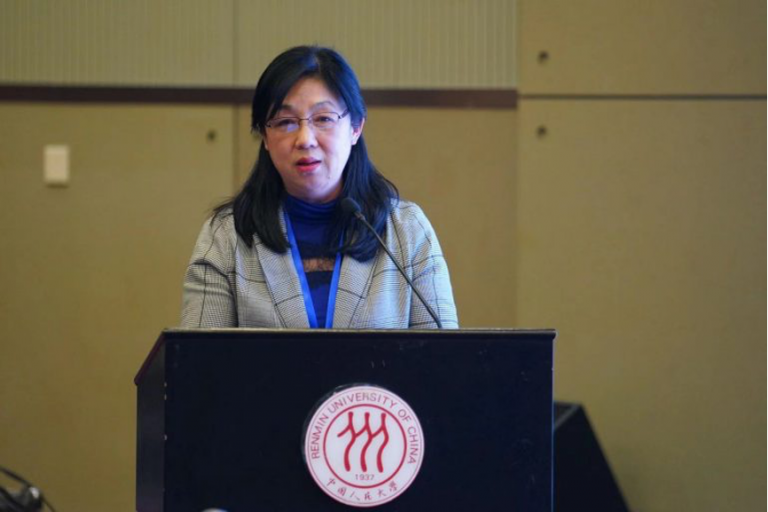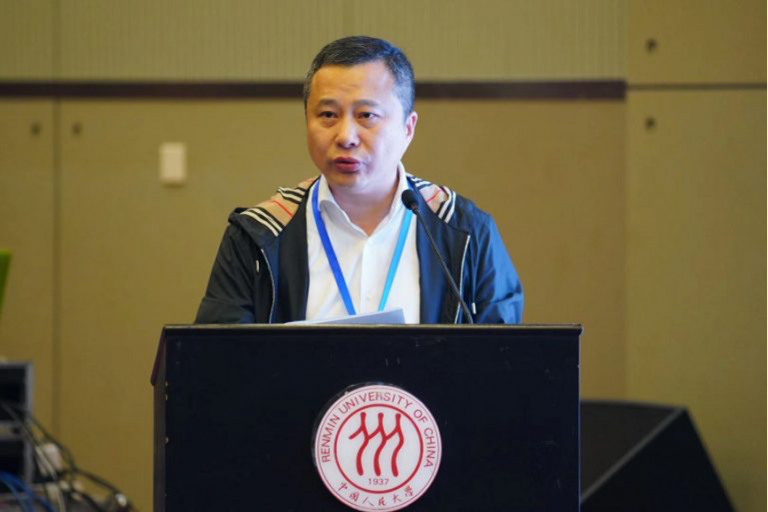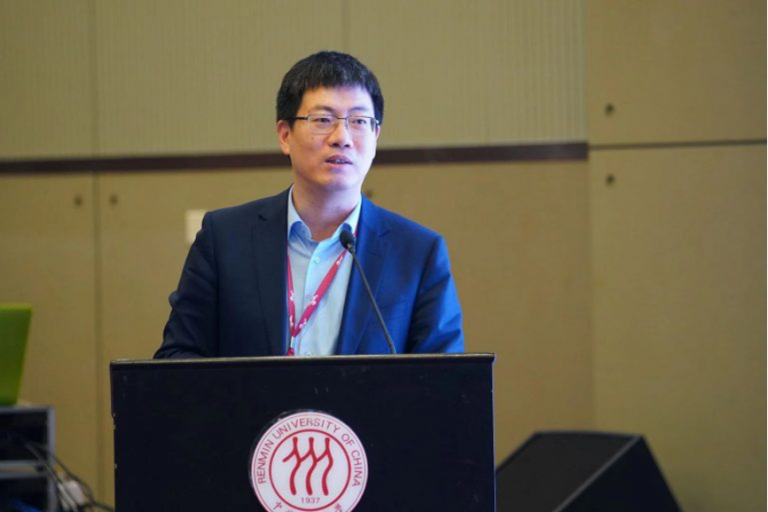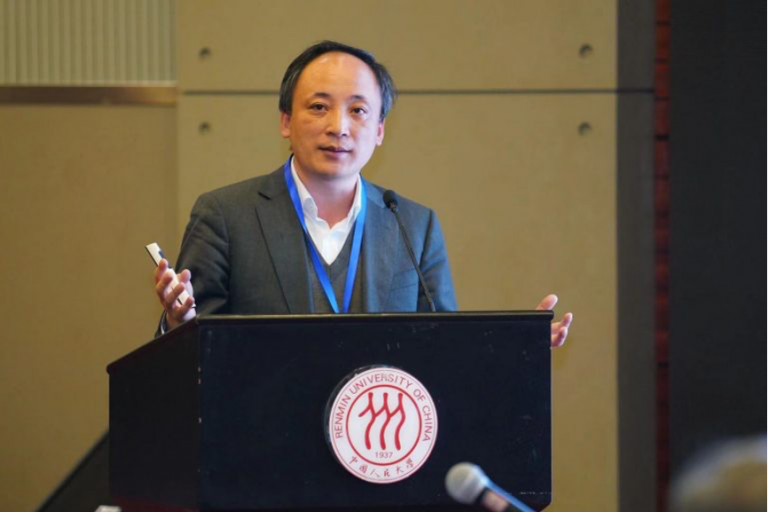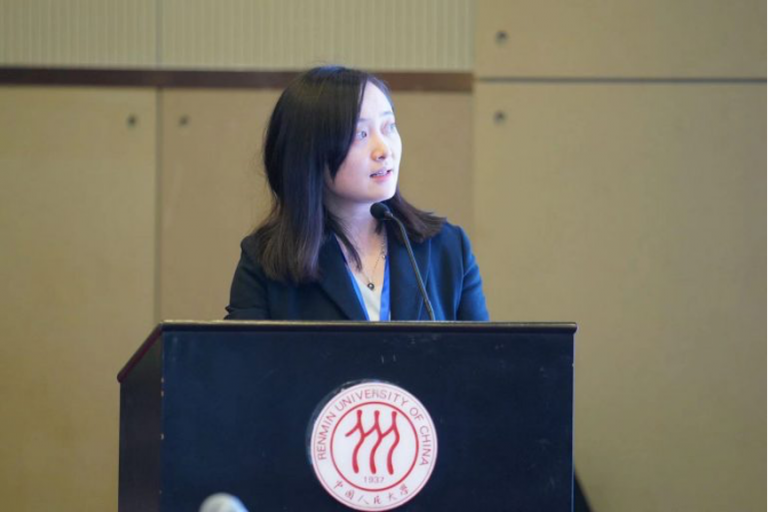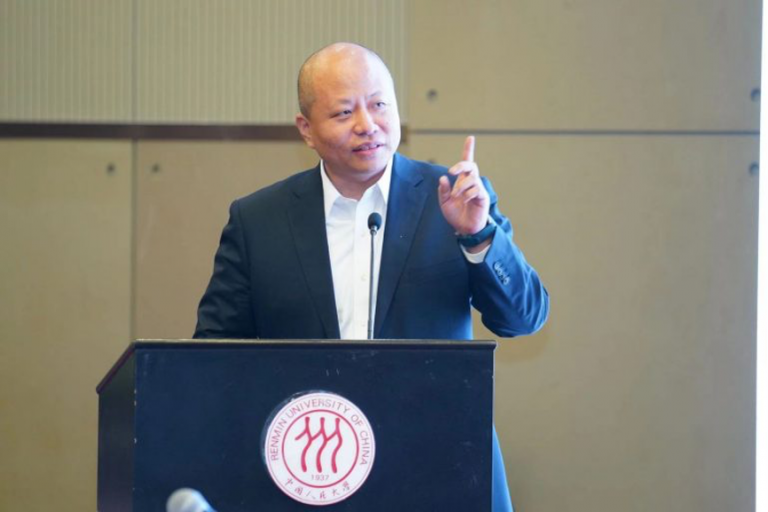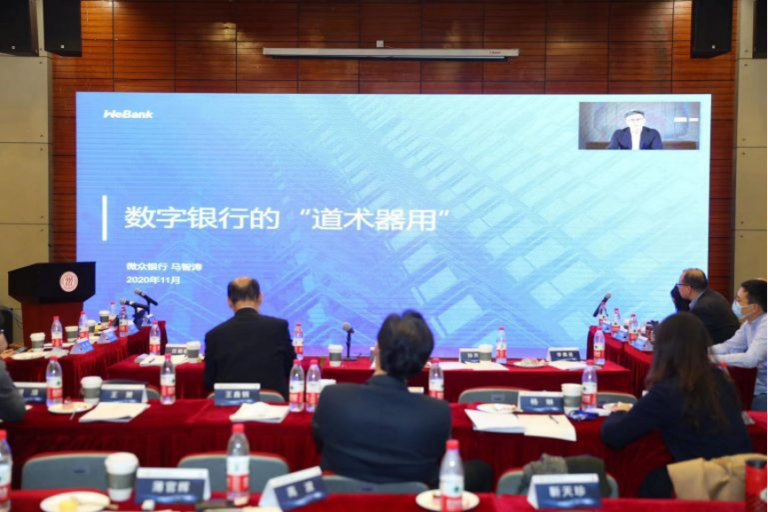FinTech Innovation Forum and Roundtable on Money and Finance
2020-11-24 IMIOn November 14th, the FinTech Innovation Forum and Roundtable on Money and Finance, jointly hosted by the School of Finance of Renmin University of China (RUC), China Financial Policy Research Center and CITIC Securities Co., Ltd., and organized by IMI, FinTech Institute of Renmin University of China and CITIC Securities Research Department, was successfully held in Renmin University of China. The theme of the symposium is Technology Empowerment and the Frontier of Inclusive Finance.
Zhuang Yumin, Council Chairman of IMI and Dean of the School of Finance of RUC, chaired the event. Wu Xiaoqiu, former Vice President of RUC and Dean of China Capital Market Research Institute, and Li Yongjin, member of the Executive Committee and Director of CITIC Securities, delivered speeches on behalf of organizers respectively. Prof Zhuang said that this forum is centered on the frontier of science and technology empowerment and inclusive benefits, and aims to have a deep discussion on frontier issues such as theories of fintech innovation and regulatory innovation model. She believes that fintech is an important starting point for China to formulate a new development paradigm in which domestic and international double development dynamic reinforce each other.
Li Yongjin expressed his gratitude and warm welcome to all participants. He said that CITIC Securities is an advocator and a practitioner of fintech in the securities industry. He observed, based on years of research, that fintech follows the trend of digital finance and breathes new life into the real economy; that data has become a key factor in policy making and business development; that technology empowers finance and drives the development of new models and new formats; and that comprehensive application of financial technologies can boost the efficiency of financial institutions. At the same time, the development of financial technologies demands better management and risk prevention abilities of financial institutions. It also demands more advanced core technologies and a safer digital environment. At the end of his speech, Li Yongjin wished the symposium a complete success that can live up to its role as a platform for high-level exchanges and interactions, and contribute to the theoretical and practical development of China’s financial technologies.
Wu Xiaoqiu put forward his suggestions on building the financial system. First, the structural reform of financial functions can only be accomplished through marketization. An important parameter to gauge financial reforms against the backdrop of, be it market-oriented reform, financial reconstruction with technologies or the opening of the financial sector, is to think whether the reform can improve the function of finance. Second, to improve the efficiency of financial service, we need technology. Expanding the range of services and improving efficiency does need the guidance of policies. But they mainly come with the emergence of new forms of finance that would be created when combined with technology. Only this can significantly boost economic benefits. Financial innovation needs to be aligned with two important trends. One is reducing reliance on capital. Financial business forms that rely more on capital and commercial banks will lead nowhere. The other is the application of technologies. These are the basic trends of financial innovation. Moreover, we need to be highly vigilant about financial risks. All forms of financial innovation and financial technologies have risks. How to hedge risks is the basic idea of risk management.
Tan Songtao, Associate Dean of School of Finance of RUC, presided the first session of keynote speech: Theoretical Basis of Digital Finance and Regulatory Innovation. Wang Zhongmin, former Deputy Director of the National Council for Social Security Fund, Chen Daofu, Deputy Director of the Financial Research Institute of the Development Research Center of the State Council, and Yang Tao, Deputy Director of the National Institution for Finance and Development attended the meeting and delivered speeches.
From a regulatory perspective, Wang Zhongmin discussed some recent important digital regulatory cases, such as the suspension of Ant Group IPO. He believes that what we need to think about is how to value such enterprises and whether the valuation can be sustained. For the high-valued fintech companies, if fluctuations occur after the official listing, the impact on the valuation needs to be assessed. He thinks that for regulation, what needs to be considered is how to accord with the regulatory requirements of information disclosure under the registration system, so as to prevent changes, which many come with listing, from bringing losses to investors in secondary market. Many people look to “Regulatory Sandbox”, but in fact, it is hard for many innovative products to come into being in the sandbox. When new products and new business forms are produced, they are more likely to be out of people’s imagination, and grow faster than people’s expectations. Regulation, particularly a perfect and intelligent one, in digital era calls for a cloud platform to realize data intercommunication with industry institutions.
Chen Daofu pointed out that data and technology had no value and power in themselves, and the latter gained its value and power while being used. Digital finance is actually the combination of a new generation of information technology and finance, forming a new business format and model. It is the reconstruction of finance. The boundaries and forms of financial institutions, businesses and markets have undergone tremendous changes. The complexity of the financial system has become more prominent and even begun to be hidden in daily production and life. Data and rules become the key to promoting financial evolution. The form and transmission of financial risks have also changed significantly, with the feature of non-linearity and self-realization more obvious. Digital finance can bring about the following changes. First, the marginal cost is greatly reduced, including the cost of reach, processing and operation. The second is to reduce or even eliminate information asymmetry, and make extensive use of the research results that human beings have. Third, it is embedded in production and life, and part of people’s cognitive and behavioral process, showing strong reflexive characteristics. The governance mode in traditional acquaintance society has been modernized. Digital finance maps the real world to digital space, greatly reducing the cost of matching and processing. The interface between reality and digital, and the processing of digital space, are the key nodes. Finance deals with the relationship between people and reallocates resources in time and space. Financial supervision is to balance the rights and obligations, and capabilities of the main bodies in the process of reallocation. Facing the fintech restructuring and a market-oriented life system which is more complex, regulatory authorities may need to be humbler to improve themselves on risk management.
Yang Tao held that China used to rely on population and other factors-driven development, but now it is shifting and seeking new drivers. The Digital transformation has changed the industrial organization, social division of labor and macro-operation of the economy. Many traditional industries, however, haven’t been digitalized enough, and they have a great potential to grow. The history of financial development is a process of technological evolution. At present, the world’s major fintech centers have their own characteristics and have made considerable progress in scale. Fintech is highly valued by countries at the strategic level. China’s Internet finance has gone through from rapid development, substantial expansion, to the phase where a large number of problems emerged and supervision was strengthened. The previously announced “regulatory sandbox” project shows that the scenarios for financial application are rich: first, provide better services and bring greater convenience and benefit to people; second, further extend the scope of financial services and explore cross-border cooperation; third, relieve the financing difficulties of small and micro enterprises; fourth, help empower the Rural Revitalization Strategy; fifth, strengthen the risk control of financial services. China’s financial industry as a whole has now come to the final stage of IT application, and just the early stage of smart technology use, accompanied by well-developed mobile technology and greater openness. Therefore, the traditional regulatory model has been unable to fully cover the current financial business.
Xiao Feifei, Executive Directer of the Research Department of Citic Securities, was the host of the second session of keynote speech, Business Model and Practices of Fin-Tech. Yang Bingbing, Vice President of China Everbright Bank, Ma Zhitao, Vice President and CTO of WeBank, Wang Dejia, Fouder and Chairman of Board of PayEgis, and Li Feng, Chief Architect of Du Xiao Man and Head of its Blockchain Department attended the meeting and delivered speeches.
Yang Bingbing said that the digitalized banking business may develop into a timely, intelligent and customized service. Timeliness means that we can maximize the coverage of financial services, and improve the accessibility through mobile services, open business model, and ecological cooperation. Intelligence enables us to to accurately identify customers’ needs through big data. Practically, we need to accumulate data assets, optimize data processing and analysis, and improve data management. Customization changes financial services from a general mode to a customized one, which involves a large number of products and intelligent recommendation, targeted industries and innovation, technological services and exclusive financial products. In the process of digital transformation, commercial banks are also facing some challenges. For example, the online operating systems needs to be improved, the supporting role of data to be enhanced, innovation to be accelerated, and short-term and long-term goals to be balanced. During its digital transformation, China Everbright Bank has adopted a variety of practical models. It can provide a timely service through the three key intelligent services, realize a intelligent service through big data, and implement its customized service through innovative applications.
Ma Zhitao said the essence of digital banking is the inclusive financial service. The huge demand for the inclusive financial service in China is an important opportunity for the development of digital banks. Digital inclusive finance is the historical mission of digital banks. Its targeted customers include small and micro enterprises, farmers, and the handicapped people that cannot be covered by traditional financial services. The method to realize digital banking is to open banking services. Compared with traditional businesses, internet banks receive a small amount of profits from a single customer. For example, 77% of the customers of WeBank’s “weilidai” are non-white-collar workers; the interests from more than 70% customers are less than 100 RMB, and the average loan size is less than 8,000 RMB. By opening our banking services and guaranteeing the great number of low-contribution customers, we can better realize implement the inclusive financial service. The weapon of digital banking is financial technology. To provide the inclusive financial service through an open banking, we need to improve our awareness in product launching, cut the cost for IT operation and maintenance, and enhance the support in case of high-concurrent transactions. WeBank has always attached great importance to technological investment and takes lead in technological development. It boasts many financial technologies including artificial intelligence, blockchain, cloud computing, and big data. The digital banks should also bear fruits. Through the application of technology, inclusive financial services can be easily obtained, cost-affordable, considerate and commercially sustainable.
Wang Dejia believes that the digital risk control is the core of digital finance. With the popularization of the mobile Internet and 5G, risk control factors have grown from “the business data” at the lower -layer with low-frequency and low-reliability to “the behavior data” at the higher-layer with higher-frequency and higher-reliability. As a result, risk control methodology has witnessed a fast development in the new age. With the bombardment of massive data, the original cloud real-time risk control is no longer able to meet requirements. According to him, we need a three-dimensional risk control prevention system that includes terminal risk control, channel risk control and cloud risk control so that a real-time risk control turns into a risk warning. An application risk control project of PayEgis is listed in the Regulatory Sandbox in Suzhou, a pilot project launched by the PBoC on Fintech innovation. Based on the big data, this project is to ensure the safety of the terminal, operation and businesses in the digital virtual network. The project can be used in the financial management, receipts and payments and payment for goods, etc. on the mobile banking and the e-commerce platform for agriculture, farmer, and rural area. It can also provide small, medium and micro enterprises with a better “Internet + agriculture + finance” service and help solve the difficulties the platform faces in production, marketing and financing.
Li Feng pointed out three aspects where the finance benefits from the technology. First, the cost has been reduced while the efficiency increased in the current model. Second, some gaps have been filled. Third, new areas have been explored. Fintech often goes through several stages in its development. The first stage is digitalization that improves the present model. The second is digital intelligence that fills current gaps. The third is digital Fintech that explores unknown areas. As data digitization develops into data capitalization, factors such as the ownership, value discovery and authorization for usage, value ownership and safety protection are also changing. The rapid development of digitalization will generate more needs of finance.
The Research Report on Fintech Innovation and Development: Data and Fintech Innovation is jointly released by Global Fintech Lab of Renmin University of China, the Fintech Institute of RUC, and the Research Department of CITIC at the end of the session. Traditional financial services are gradually becoming complex and diversified new financial models that adopt technologies in payment, credit and wealth management along with its integration with massive customers, scenarios and data in the Internet era. On how to improve the quality and efficiency of financial services, promote a sound and sustainable development of the Fintech, and to protect rights and interests of Fintech users, the report elaborates the following four points: first, the Fintech means that the technology helps enhance the efficiency of finance; second, the development of payment technology facilitates the capital flow and capture the data at the gateway; third, the development of the credit technology reflects the process from credit data to data credit; fourth, the development of wealth management enables a better management of long-tail customers’ wealth and improves institutions’ capability of allocating assets. Moreover, the report puts forward three suggestions: first, speeding up the top-layer design of data governance rules; second, accelerating the design of data governance rules in the Fintech; third, improving the regulatory framework of Fintech.
